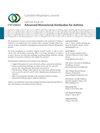COVID-19后患者心肺运动能力测试持续损伤:单中心经验
IF 2.1
4区 医学
Q3 RESPIRATORY SYSTEM
引用次数: 10
摘要
背景COVID-19后,患者经常出现慢性疲劳和主观运动能力下降(EC)等持续症状,最近被描述为急性后COVID-19综合征。目的探讨新型冠状病毒肺炎(COVID-19)后EC降低的客观情况,并评价其病理局限性。方法对30例主观限制心电图的患者进行心肺运动试验(CPET)。如果客观上限制EC或氧脉冲恶化,我们提供心脏应激磁共振成像(MRI)和随访CPET。结果男性18例,女性12例。11/30(36.7%)患者检测到有限的相对EC。限制与体重指数的峰值氧(O2)摄取(峰值氧(O2) /kg)降低相关(平均74.7(±7.1)% vs. 103.6(±14.9)%,p < 0.001)。局限性EC患者中有18/30(60.0%)出现峰值氧/kg降低。EC降低的患者普遍表现为最大氧脉冲受损(75.7%(±5.6)vs. 106.8%(±13.9),p < 0.001)。局限性EC患者均未见异常气体交换。此外,没有患者出现肺灌注减少的迹象。通过心脏MRI, 16例患者排除了双心室射血分数降低作为氧脉冲降低的可能原因。尽管进行了非控制性的训练,后续的CPET并未显示出任何锻炼的改善。结论EC的恶化与通气或肺血管受限无关。运动限制与O2脉冲降低和峰值O2/kg相关,但与COVID-19的初始严重程度无关。我们假设微循环受损或外周氧利用受限可能是急性COVID-19感染后EC长期恶化的原因。本文章由计算机程序翻译,如有差异,请以英文原文为准。
Sustained Impairment in Cardiopulmonary Exercise Capacity Testing in Patients after COVID-19: A Single Center Experience
Background Following COVID-19, patients often present with ongoing symptoms comparable to chronic fatigue and subjective deterioration of exercise capacity (EC), which has been recently described as postacute COVID-19 syndrome. Objective To objectify the reduced EC after COVID-19 and to evaluate for pathologic limitations. Methods Thirty patients with subjective limitation of EC performed cardiopulmonary exercise testing (CPET). If objectively limited in EC or deteriorated in oxygen pulse, we offered cardiac stress magnetic resonance imaging (MRI) and a follow-up CPET. Results Eighteen male and 12 female patients were included. Limited relative EC was detected in 11/30 (36.7%) patients. Limitation correlated with reduced body weight-indexed peak oxygen (O2) uptake (peakV̇O2/kg) (mean 74.7 (±7.1) % vs. 103.6 (±14.9) %, p < 0.001). Reduced peakV̇O2/kg was found in 18/30 (60.0%) patients with limited EC. Patients with reduced EC widely presented an impaired maximum O2 pulse (75.7% (±5.6) vs. 106.8% (±13.9), p < 0.001). Abnormal gas exchange was absent in all limited EC patients. Moreover, no patient showed signs of reduced pulmonary perfusion. Using cardiac MRI, diminished biventricular ejection fraction was ruled out in 16 patients as a possible cause for reduced O2 pulse. Despite noncontrolled training exercises, follow-up CPET did not reveal any exercise improvements. Conclusions Deterioration of EC was not associated with ventilatory or pulmonary vascular limitation. Exercise limitation was related to both reduced O2 pulse and peakV̇O2/kg, which, however, did not correlate with the initial severity of COVID-19. We hypothesize that impaired microcirculation or limited peripheral O2 utilization might be causative for prolonged deterioration of EC following acute COVID-19 infection.
求助全文
通过发布文献求助,成功后即可免费获取论文全文。
去求助
来源期刊

Canadian respiratory journal
医学-呼吸系统
CiteScore
4.20
自引率
0.00%
发文量
61
审稿时长
6-12 weeks
期刊介绍:
Canadian Respiratory Journal is a peer-reviewed, Open Access journal that aims to provide a multidisciplinary forum for research in all areas of respiratory medicine. The journal publishes original research articles, review articles, and clinical studies related to asthma, allergy, COPD, non-invasive ventilation, therapeutic intervention, lung cancer, airway and lung infections, as well as any other respiratory diseases.
 求助内容:
求助内容: 应助结果提醒方式:
应助结果提醒方式:


